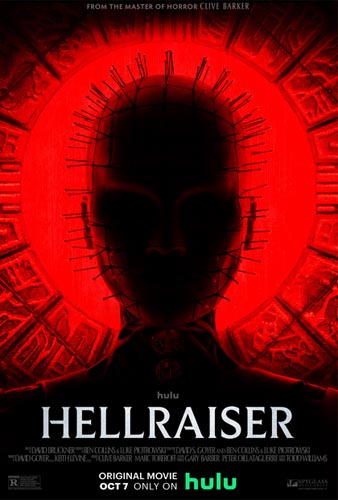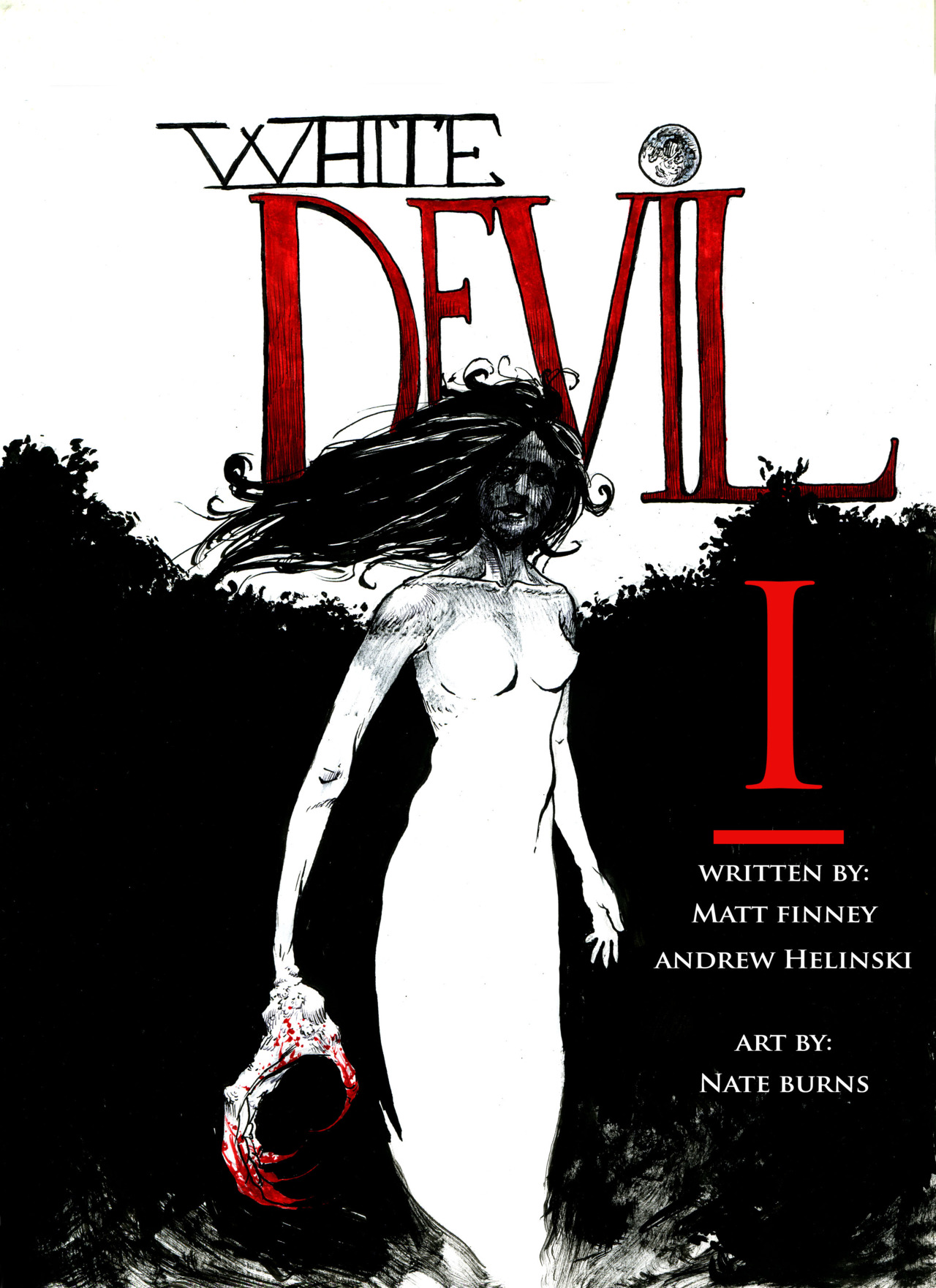Hellraiser (2022)
Directed by: David Bruckner
Written by: Ben Collins, David S Goyer, Luke Piotrowski
Starring: Adam Faison, Aoife Hinds, Brandon Flynn, Drew Starkey, Goran Visnjic, Jamie Clayton, Jason Liles, Kit Clarke, Oessa A’Zion, Selina Lo, Yinka Olorunnife, Zachary Hing

HELLRAISER (2022)
Directed by David Bruckner
So… in the tradition of Nightmare on Elm Street 2010, Ghostbusters 2016, Doom 2016, Halloween 2018 and Candyman 2021, we are re-using former titles without differentiation, forcing us to include the year of release. It’s the only way.
Hellraiser 2022 was released in 2022, thirty-five years after the original masterpiece and four years since the previous entry, Gary J Tunnicliffe’s Hellraiser: Judgment. This is not a remake of the original, as I’d been expecting for the longest time (which is a relief), but a whole new take on the Hellraiser series and mythos. There’s a noticeable budget increase for this entry from Judgements meagre $300,000 to this movie’s more replete $14 million – and it shows.
The production values are solid and the special effects simply pop off the screen. In particular, the transitions from “reality” to hell are the best in the franchise; one notable highlight being Aoife Hinds’ character Nora who is collapsed in the back of the van when the front seats and back doors start to slink off into the distance, leaving her trapped in one of Leviathan’s hallways. The box is more of a shapeshifter this time, changing as though it were Jim Carrey’s facial expressions. CGI enhances the box, as was done with Jim Carrey’s face in The Mask, and is also necessary as there’s literally no physical way a prop could have performed the same transitions. This I don’t mind as this is a franchise where impossible things happen, the Hellraiser series has always followed a sort of “fairy-tale” logic. I will say that the original box being a physical prop has its own charm, but this is the time we are living in, and the box is now 50% CGI.
The direction is interesting. There’s a care taken with the camera in that what we, the audience, want to focus on and where the focus of the camera actually goes do not always align. The first instance of this, let’s call it “denial of focus” is the movie’s first victim, who gets chained up in the background, his screams are loud and clear but he is out of focus, instead Goran Višnji?’s Roland Voight is centre stage as he summons the God of the Labyrinth, Leviathan (though we the audience are not yet aware of this). I wanted to see the victim in all his gory detail, but he is blurry because he is not important in the shot, Roland Voight is, or he is, at least, a man of self-importance and the framing device here is used to signify to the audience how little regard this man has for the suffering of others. Roland doesn’t even look the way of the victim and he starts talking to the aforementioned unseen entity. This is picked up later. The second instance is when the box changes, the positions are reversed, where Roland was close to the camera and in focus, this time the box is close to the camera but out of focus, that time we are looking at Riley as she nearly passes out in front of a public toilet. Her brother is inside, getting ceno-bitten (see what I did there?). We can’t quite see what is happening with the box, and neither can our protagonist, because she is out of it, literally. The film factors into its framing the view points of our characters.
The focus is on the characters in both shots. It’s artistically done. I liked it. I wished I liked the characters more. The predominantly young cast struggle to make their presence felt. Where the original film had the Julia, Frank and Larry triumvirate to keep the viewer entertained between the cenobite scenes during 1987s original, Odessa’s Riley, the boyfriend, her brother, the brothers boyfriend, and friend are simply not as engaging. Riley is a recovering drug addict who is far from the end of her journey. She is in full blown self-sabotage mode, a grenade that has pulled its own pin. She is freeloading off her brother and not above stealing – à la the safe, which makes her a difficult to root for protagonist. She’s not got Kirsty Cotton’s innocence, smarts nor strength of character. Riley is someone who would likely end up like Julia, seducing and killing men to see her lover return. In fact, she actually is seeking the resurrection of someone just like Julia did though the film can’t paint her as a villain – though I dare say that may have worked. There’s another friend, Nora, who I was not entirely able to figure out, who’s friend is she? She just seems to follow the group around and generally comes across as being stumped for conversation. I really feel like she joined the cast on their trip to the Voight mansion because she had nothing better to do. There are moments, flashes of sharp dialogue, “did you really just turn the TV down to hear us argue?”, but they are too few and too far between. There’s a lot of perfunctory dialogue, which for young characters can be fine, it worked for the Final Destination movies, but Hellraiser is a different beast. It relies on strong characters to engage the audience in-between the Cenobite scenes. I’ve often thought that Hellraisers are structured like Marvel’s Hulk movies where we are perpetually waiting for Bruce Banner to simply “Hulk Out”, in Hellraiser we wade through the calm bits with the humans waiting for the Cenobites to appear, for the movie to ‘Hulk out’. The original had a fantastic, electric dynamic between Larry, Julia and Frank. Every scene pushed the story forward and I wanted to know what happened next. Julia’s descent from bored housewife to seductress/murderess is brilliantly done. But with Hellraiser 2022, this is not what we have. There is no arc like Julia’s here. There is no Julia full stop (bring back Julia). Only twenty somethings getting perplexed for a weekend. I would imagine writing the human characters in a Hellraiser movie is the toughest part to do, it’s also the most important because, however you cut it, these are the characters who your audience are going to be spending most of the runtime with.
I will say the cenobites are fantastic and Goran Višnjic’s Roland adds gravitas that is usually reserved for the pinhead character. He also excellently sells the pain the character endures after he has what looks like clock parts meshed with his flesh.
The original box has always had a number of configurations; it formed a Leviathan shape in Hellraiser 3: Hell on Earth and it was seen in the form of a sphere in Hellraiser 6: Hellseeker (there might be others, can’t remember off the top of my head, but there were not many) but exceptions aside, the usual repertoire involved a section that would raise up and move back and forth, bit of a nothing burger, then the central cylinder would raise up and turn and click back down, transforming the box into more of an eight-pointed star, cue Doug Bradley’s arrival and subsequent mayhem. This new film gives us a new box, and this one is far more changeable than before with six strictly defined configurations and each configuration brings the “user” closer to an audience with the God, Leviathan who can grant one of six predefined wishes (three of which are demonstrated). Surprises this time are the spikes that spring out of the box, deliberately designed to maim. This is necessary as this version of the box soaks blood up like a sponge (which must be great for hiding the evidence at a murder scene) – only to regurgitate it later in a very unsettling sequence (the blood flows upwards! Francis Ford Coppola’s Dracula anyone?).
Leviathan is back, last seen in 1988s Hellbound: Hellraiser 2 (I have always felt they got the title of the first sequel back to front, but that’s what we’re stuck with) and has not changed at all. The God of the Labyrinth in this film is identical to its previous appearances, so much so that I started wondering if this film shared continuity with the earlier Hellraiser films. Technically, there’s nothing in this film that would discount it, the cenobites we see here could simply be a different Order of Cenobite that are summoned via a different box. I personally prefer the idea that all the films in this series share continuity and whilst this might not be true, it’s a very pleasant change from whatever is going on with the Halloween films.
Pinhead is back and this incarnation is portrayed by Jamie Clayton, who, I have to say, has the perfect voice for the character, best since Doug Bradley himself. This Pinhead shares a lot of the previous Pinhead’s characteristics, strange eloquence and regal posture, and is in full control of those hooked chains. One thing I liked, as a fan of the series, is the confirmation that only Pinhead controls the chains – this was never clarified in the franchise before now, only hinted at. The female cenobite, larger neck wound this time, telepathically controls wires, and she lands herself one-and-a-half victims. Yes, you read that right. Watch the film.
The cenobites have been taken to their logical extreme and are now truly a sight to behold. They wear no clothes, this time their skin has been fully refashioned. They’ve become a visual curio and I found myself trying to inspect the designer wounds covering their bodies. “The Gasp” has openings on its back, either side of the spin, where you can see their lungs expand and contract with each wheezy breath. Very grisly. There are some cenobites that sport wounds that go beyond what an actual person could suffer, for instance one cenobite, called “The Mask” has no observable head! He’s just face skin stretched taught over a wire frame. He talks too, despite having no head. No rest for the wicked eh.
Plot hole – maybe… but I was wondering, the box needs six victims before Leviathan can be summoned and bestow the Monkey-Paw wish upon the summoner. Throughout the film, we gather up six victims but then both Voight and Riley get their wishes granted. I would have thought only one of them got an audience with God. It’s a sale, 50% off on demands for the damned. Don’t miss out. Claim your own back-firing wish now! This may be splitting hairs as ceobites have never really stuck to a code – in the original film they say they’ll let Kirsty go if she brings them Frank, they then immediately renege on that loose agreement and predictably so. Roland Voight gets turned into a cenobite himself, it’s a grisly scene, and a great one to conclude the film with.
I really enjoyed this film. I always felt the budget could never match the scope of imagination embedded in the Hellraiser films, and here we are, what we see on screen matches the imagination. The story is not as good as the original, but it is better than a lot of the sequels. I feel more effort was put into getting the lore right for this film than making a truly engaging story but that’s ok. Do I want to see more of this brand of Hellraiser, yes I do.
Rating: 













Be the first to comment